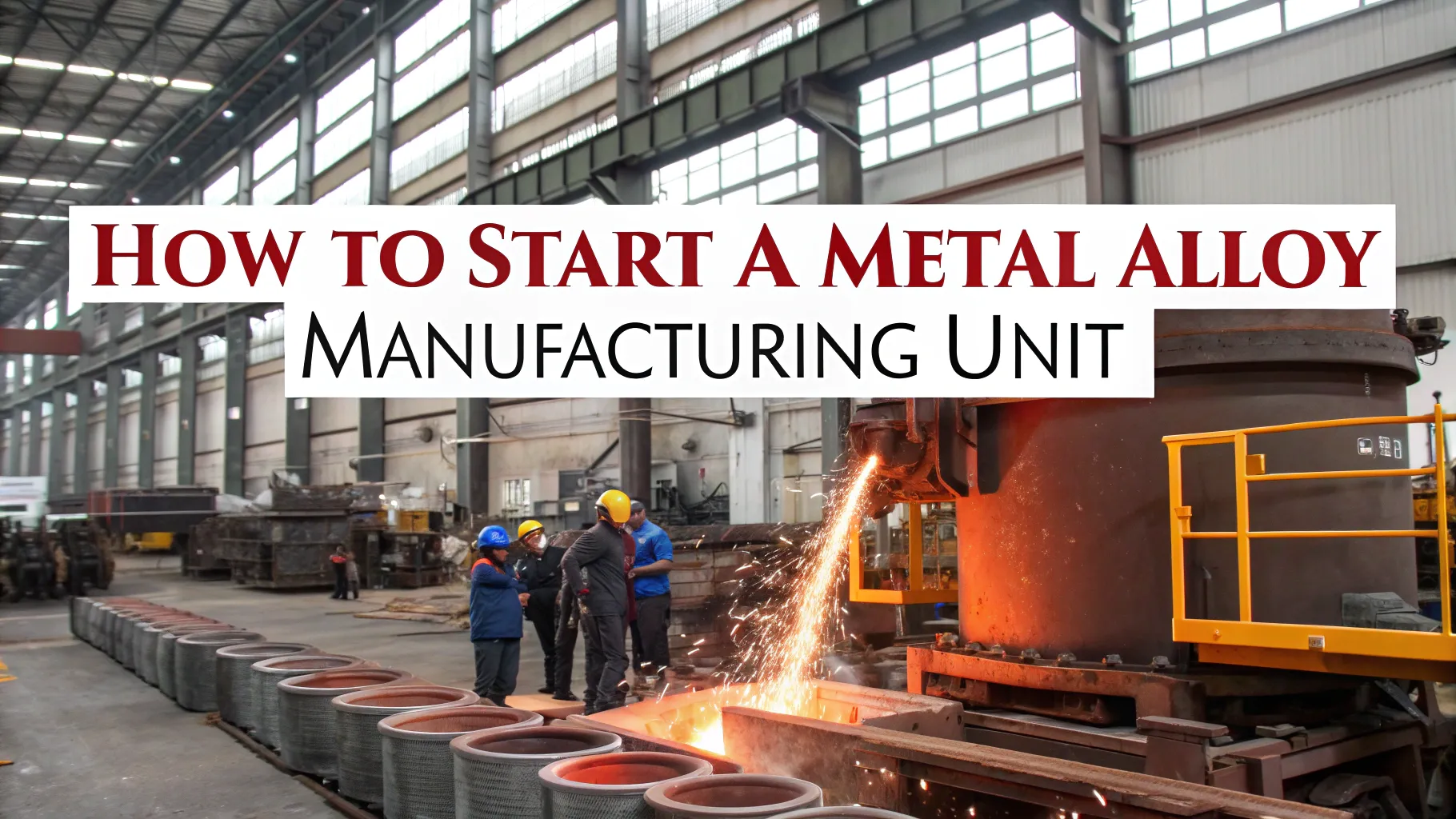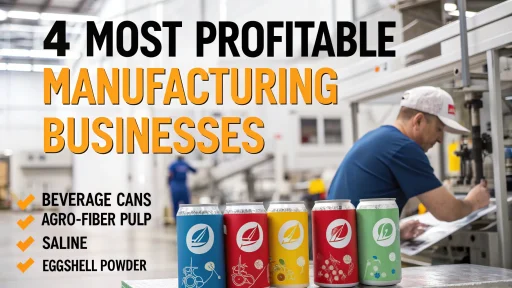The rapid growth of industries such as pharmaceuticals, automotive, as well as energy and electronics in India has put metal alloy manufacturing at the top of growth in the industrial sector. It is a startup-friendly, scalable and thriving area. The sector has a lot of potential for entrepreneurs seeking to create sustainable B2B companies, particularly those who are transitioning from chemical or pharmaceutical backgrounds that are already familiar with manufacturing processes and systems.
Material scientists engineer mixtures of two or more metals—or metals combined with non‑metals—to boost durability, corrosion resistance, ductility, and electrical conductivity. Manufacturers use stainless steel in medical apparatus and aluminum alloys in light‑EV components, applying these materials across nearly every industry vertical.
If you’re thinking of how you can get into this technologically highly-demanding, yet incredibly rich segment this article offers detailed step-by-step instructions.
Why Metal Alloy Manufacturing Is a Strategic Business Opportunity
India is one of the top-growing markets for base metals as well as specialty alloys. With the government pushing for production in the country under the Atmanirbhar Bharat initiative as well as PLI programs for industries like electronics, defense, EVs and infrastructure, demand for customized alloys is increasing rapidly.
Pharma as well as chemical entrepreneurs could make use of their previous knowledge of process control, QA/QC processes and industrial compliance to look into the manufacturing of alloys, which has similar plant-scale processes that include furnaces, reactors, and even automation.
With the increasing substitution of imports and FDI in defense and metals manufacturing and defense manufacturing, there is a growing demand for the localized production of alloys.
Related: Top 5 Profitable Metal Alloy Businesses to Start in India
Step-by-Step Overview: How to Start a Metal Alloy Manufacturing Unit
Beginning a manufacturing unit requires a combination of market planning, technical planning, mapping, and alignment with the regulatory environment. Although each type of alloy (e.g., ferrous vs. non-ferrous) is unique and has its particularities, the general structure of establishing an operation includes some crucial stages.
1. Select Your Alloy Focus Based on Market Demand
In lieu of trying to cater to all segments, concentrate on a specific type of alloy with a consistent demand in the industrial market. A few of the most sought-after categories are:
- Alloys of stainless steel (used in the food, pharma as well as construction)
- Aluminium alloys (especially in automobile parts, electricals and frames for electric vehicle batteries)
- Copper-based and brass alloys (critical to electrical components)
- Chromium and nickel-based alloys (used in the fields of aerospace heat exchangers, as well as defense)
Understanding the end-user industries (such as manufacturing EVs that require lightweight frames or pharmaceutical firms that require non-reactive stainless steelwill help you identify your market more specifically.
2. Understand the End-to-End Manufacturing Process
The manufacturing process for alloys may be batch-wise or semi-continuous based on the material and design of the plant. The process generally includes:
- Technicians weigh mineral concentrates or metals such as iron ore, aluminum scrap, and nickel—to precise proportions.
- Melting and refining: These can be heated using furnaces (arc induction, electric) at set temperatures to form an homogeneous melt. Deoxidizers and purifiers are added to improve the alloy.
- Tapping and Alloying The molten metal is infused with alloying agents such as chromium, zinc or manganese. Tapping into molds or ladles is the next step.
- Forming/casting: The molten alloy is formed into ingots, or is passed via rolling mills and wire drawing extrusion or forging depending on the use.
- Heating Treatment, Finishing and The controlled cooling process, whether annealing tempering, or quenching improves mechanical properties. Final stages involve finishing the surface or coating, if needed.
Each stage needs to be monitored closely of compositions, temperatures, and levels of impurity. Integration of digital control panels and laboratory-based spectrometry testing increases the quality and reliability of each stage.
3. Setup Requirements and Regulatory Considerations
The alloy plants need industrial zones, fuel and power connectivity as well as effluent treatment systems and a layout that will ensure the safety of your workers as well as productivity. The layout must also be in line with the following requirements:
- Pollution Control Board approvals (for emission as well as waste disposal)
- Factory Act and Labor compliance to ensure worker safety and well-being
- Raw Material Sources allows (especially when you are recycling scrap metals or recycled metals)
- BIS and ISO standards, based on the type of product you are using (e.g., IS 6911 for stainless steel)
A plant layout which ensures a seamless flow of materials as well as process insulation and safe loading/unloading areas is crucial. When working in the field with copper chrome, nickel or it is essential to pay attention to the safety of your environment and health.
Related: How to Profit from Rare Earth Alloys
Top Applications Driving Alloy Demand in India
Understanding the customer segments you serve and developing your products to meet their needs is vital. These are currently the fastest growing areas for alloy-based products in India:
- Automotive and Electric Vehicles: Aluminum alloys that are lightweight replace traditional components for greater mileage.
- Pharma & Healthcare: Stainless alloys of titanium and steel are employed in surgical tools such as containers, reactors, and instruments.
- Defense & Aerospace: Advanced titanium and nickel alloys are demanded for toughness and corrosion resistance.
- Electronics and power: The copper alloys are essential to the wiring, switches and connectors.
- Renewable Energy: Alloys that are used in the wind turbine’s parts and solar mounting structures as well as hydrogen fuel system are attracting an increase in demand.
The coming years will also see an the demand increase for low-carbon and recyclable alloys, in particular when India joining circular economy and clean energy commitments.
Tips to Build a Competitive Advantage as a New Entrant
Achieving success in the field of alloy manufacturing involves more than simply setting up furnaces and equipment. Entrepreneurs must focus on four main areas to ensure longevity:
- Precision in Quality Control
Utilizing spectrometers, carbon-sulfur analyzers and electronic control systems will ensure that your products meet the requirements of customers. - Customized Product Development
Many B2B buyers are drawn to custom formulations or materials that are performance-specific. Offering alloy R&D services to such customers can result in brand recognition. - Efficient Logistics and Raw Material Sourcing
Develop connections with importers, scrap dealers or mining companies to ensure an uninterrupted supply of input. Also, consider optimizing the location of your plant close to hubs for customer service. - Environmental Compliance and Certifications
Being RoHS, REACH, or ISO-compliant will allow you to gain access to export markets or supply MNCs who comply with worldwide ESG guidelines.
For more information, watch this video
Future Outlook of Metal Alloy Manufacturing in India
The development of urban infrastructure electric vehicles, electric cars, pharmaceutical equipment exports, as well as Make in India for defense and aerospace are bringing about specific alloy requirements.
With India’s capacity in domestic primary metal production growing (e.g. aluminium smelters operating in Odisha and hubs for steel in Gujarat as well as Maharashtra) the alloy industry can benefit from localized production and the growing demand for downstream.
The metal alloy market is growing in popularity with strategic and private equity investments because of its importance in the field of future-tech. Since India promotes itself as a potential manufacturing partner to China and other countries, specialty alloys with exceptional capability to customize will be an integral part of the ecosystem.
Final Thought: Why Entrepreneurs Shouldn’t Miss This Opportunity
Manufacturing metal alloys isn’t just a business for industrial use. It’s also a platform for creativity. If you’re transitioning from chemical processing, pharmaceuticals, and engineering. The fundamental abilities in process discipline safety systems, process discipline, and operational controls are easily transferable.
With both export and domestic demand with clear industrial applications and increasing assistance from government schemes beginning an metal alloy manufacturing offers the potential for scale and strategic significance.
If you’re looking to establish your business with professional assistance, Niir Project Consultancy Services (NPCS) can assist. NPCS creates Market Survey cum Detailed Techno Economic Feasibility reports for entrepreneurs. The reports cover manufacturing processes raw materials, layout of the plant, and financials. They aid in assessing the commercial and technical feasibility of establishing new industries.






